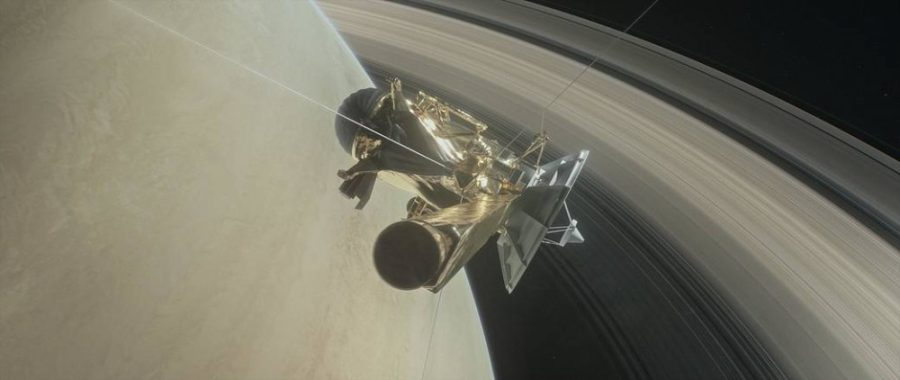On Friday, Sept. 15, the Cassini spacecraft orbiting Saturn will hurl itself into the gas giant, ending its twenty-year long mission. In its final moments, the spacecraft will collect unique data unlike anything seen before, including samples of Saturn’s atmosphere and various pictures of the planet.
Launched in 1997 by the Titan rocket, Cassini did not enter Saturn’s orbit until 2004. Cassini came equipped with twelve different instruments and devices designed to record everything from magnetic fields to atmosphere effects and pictures, according to University of Arizona professor of planetary surface processes and Cassini researcher Robert Brown.
“Saturn has an interesting and really dynamic atmosphere,” said Brown. “You can learn a lot about the Earth’s atmosphere and how atmospheric circulation works by looking at other planets.”
Cassini has also been used to research Saturn’s rings and two of its moons, Enceladus and Titan, thought to hold the capability to harbor organic life. This research also has broader implications, according to Brown.
“If you understand the chemical composition of materials in the Saturn system, you get an understanding of how the solar system works,” Brown said.
Enceladus has a core hot enough for liquid water to exist under its crust, with geysers of water bursting forth from its south pole. The crust is composed of ice, which extends several kilometers down under the surface.
“Liquid water in contact with what we believe to be a rocky interior gives us the sense that perhaps the conditions inside Enceladus are similar to the conditions that might have existed in early Earth,” Brown said.
RELATED: One year after launch, OSIRIS-REx flies by Earth
The existence of liquid water and conditions similar to a primeval Earth make for excellent research into the formation of life, not just here but hopefully in alien worlds. Brown said that evidence for a rocky core comes from the gravity field, which is affected by the distribution of mass.
“We don’t know that for sure though, because we haven’t looked,” Brown said.
Cassini also came supplied with a probe named Huygens, which landed on Titan. The probe gathered data on the composition of Titan’s atmosphere, which is composed mostly of nitrogen.
Brown said the pressure is nice enough that with a respirator one could explore Titan without a spacesuit, if they could handle the chilling cold.
“The most interesting aspect of Titan is that it has free liquid on its surface, what we would call lakes and seas in terms of their size,” Brown said. “But that’s where the analogy ends, because they’re composed of liquid methane, ethane and propane.”
These two moons are the greatest reason Brown said they’ll be sending Cassini into Saturn. These moons harbor the chance for life, and they don’t want to contaminate them with materials from Earth, should Cassini crash into them.
Of course, Huygens has already landed on Titan, which carries its own concerns for contamination.
“They did everything they could to clean and sanitize it,” Brown said. “When we started this mission in 1990, we weren’t concerned as much with what we now call planetary protection.”
The Grand Finale phase of the Cassini mission, which started back in April, has been putting the spacecraft dangerously close to Saturn itself and the rings.
“The big advantage of doing that is you get better resolution of the rings and higher detail of the planet,” Brown said. “Another theme is that we’ve been sampling areas of the magnetosphere that we couldn’t sample otherwise.”
RELATED: The future of battery power: You
A majority of the important samples have already been taken, but the unique data that will be gathered in the last moments include samples of Saturn’s atmosphere and infrared images of the general area where the spacecraft will burn up.
Brown said at best, Cassini will last a minute as it tumbles through the atmosphere.
“Cassini has all these things sticking out, and so it’s going to tumble as a result of drag,” Brown said. “Its control systems won’t be able to hold it in a fixed position. That’s when it’ll lose contact with Earth.”
The end of Cassini also acts as a great learning opportunity. From Cassini, Brown said he can learn new efficiency techniques, what kind of questions they should be asking and what needs prioritizing.
“When you understand the objects better, you can plan ahead,” Brown said. “A lot of times you don’t know what you should know, and by understanding the planets, you know what kind of questions to ask the instruments needed to answer those questions.”
A new proposal is on its way to NASA for the next generation of New Horizon spacecraft to go back and possibly orbit Titan, a proposal which Brown is currently working on.
“The most important question from a philosophical point of view is are we alone, and from my perspective the answer to that question is very important,” Brown said.
Follow William Rockwell on Twitter









